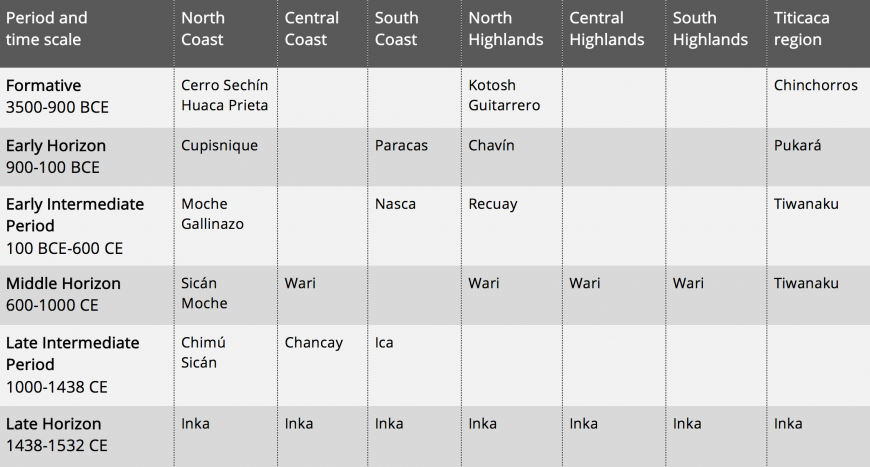Andean Cultures
Timeline

Geography
The Andes region encompasses the expansive mountain chain that runs nearly 4,500 miles north to south, covering parts of modern-day Venezuela, Colombia, Ecuador, Peru, Bolivia, Chile, and Argentina.
the Andes mountains give way to arid coastlines, fertile mountain valleys, frozen highland peaks that reach as high as 22,000 feet above sea level, and tropical rainforests.
Flora / Fauna
maize (corn), hot peppers, potatoes, celery, manioc, cotton, and coca
vicuna and guanaco
vicuna became llamas, used for carrying loads up to 100 pounds
guanaco became alpacas, had soft, easily sheared wool
Textile Arts
developed textile technology before ceramics or metallurgy
first made from reed fibers, then changed to yarn made from cotton and camelid fibers
Cotton grows on the coast and had several colors including white, several shades of brown, and a soft grayish blue.
Alpacas were in the highlands, had soft, strong wool in white, brown, and black.
red dye from cochineal, blue from indigo, and other colors from plants that grew at various elevations. Alpaca wool was generally prefered for clothing as it was easier to dye
Bright colors were a status symbol due to time and effort it took to create them
Ceramics
mostly fired in an oxygenating atmosphere, the iron content in the clay created a red cast
the Sicán and Chimú used kilns that deprived the clay of oxygen as it fired, which made brown to black surfaces.
Decorated through incising, rocking seashells over the damp clay, or by painting
some early elite ceramics were painted after firing with a substance made from plant resin and mineral pigments, could withstand being heated so only for display and ritual
most ceramics were slip painted, range of colors from 2-7 or more
Metalwork
earliest known metalwork dates to 2100 B.C.E.
evidence of copper smelting from around 900–700 B.C.E.
Gold was used for jewelry, ornaments, and sculptural pieces.
Inka made gold and silver figurines of humans and llamas
Copper and bronze were also used to create jewelry and items like ceremonial knives (called tumis).
Architecture
highland traditions
tended to build with stone
coastal traditions
tended to use adobe
however, oldest complex site in the andes (Caralm 2800 BCE), a lowland site, was built mainly with stone.
general features
platforms, temples, walled compounds as the focus of political or religious power
the Inka developed a stone technique that protected structures from earthquakes.
Art as a whole
was meant to be touched, worn, held, maneuvered, or ritually burned.
Some works were never seen or used by the living. Mortuary art, for instance, was essentially created only to be buried in the ground.
Works of art associated with particular rituals, on the other hand, were often burned or broken in order to “release” the object’s spiritual essence. Earthworks and architectural complexes best viewed from high above would have only been “seen” from the privileged vantage point of supernatural beings. Indeed, it is only with the advent of modern technology such as aerial photography and Google Earth that we are able to view earthworks such as the Nazca lines from a “supernatural” perspective.
Art was often conceived within a dualistic context, produced for both human and divine audiences.
The nearby Nazca culture is best known for its monumental earthworks in the shape of various aquatic and terrestrial animals that may have served as pilgrimage routes. The Inkas, on the other hand, produced windowed monuments whose vistas highlighted elements of the adjacent sacred landscape. Andean artists referenced, invoked, imitated, and highlighted the natural environment, using materials acquired both locally and through long-distance trade.
environmental specificity